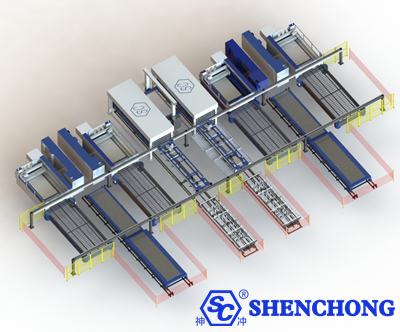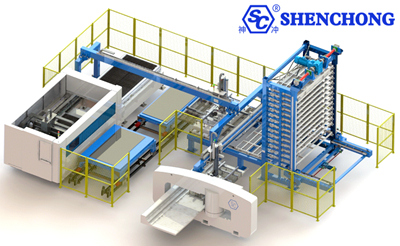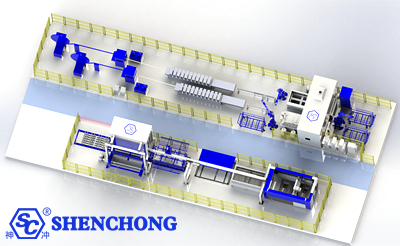
After the 20th century, stamping equipment and cold stamping molds gradually became applied in the field of sheet metal processing. In the 1980s, sheet metal CNC machining began to emerge and gradually developed along the direction of mechanization, semi automation, automation, and intelligence.
The research on sheet metal flexible production lines started earlier in foreign countries. In the 1880s, Western countries began to use sheet metal flexible production lines. However, the development of sheet metal processing in China lags behind that of developed countries, which also leads to a certain gap between the sheet metal flexible production line system and Western countries.
After 30 to 40 years of development and continuous improvement in manufacturing technology, Lean production and flexible production systems have been rapidly developed and widely applied in China. In the future, flexible production lines will become an indispensable configuration for sheet metal processing plants.

On the basis of achieving lean production, enterprises often modify local equipment or equip auxiliary devices to achieve production automation, reduce manual intervention, and improve production efficiency in order to fully tap into the potential of equipment.
Modifying equipment is easily limited by the original conditions of the machine tool, making it more complex and often only suitable for small modifications. However, equipping equipment with auxiliary devices has a wider range of applications.
A CNC punching machine equipped with an automatic loading and unloading mechanism. During production, the forklift pallet places raw materials in the waiting area, and the equipment synchronously performs automatic loading and unloading, semi-finished product unloading and stacking.

Workers only need to cut off the micro connections on the semi-finished product and organize and stack them. This working mode not only reduces the labor intensity of workers, but also reduces the number of workers, allowing one person to operate two machines.
A CNC punching machine equipped with automated material storage and automatic loading and unloading devices can seamlessly connect with the feeding machine during the production process, reducing the need for manual replacement of raw materials.
On the human-machine interface, multiple numerical punching programs for different specifications of sheets can be arranged at once. After completing the processing of different semi-finished products, they can be stacked and returned to the warehouse by themselves. Workers are responsible for feeding ingredients to the material warehouse and cutting off micro connections, without the need for manual intervention. This configuration method is also applicable to laser cutting machines.
The operating speed of the automated material warehouse is directly given by the bus, which improves the timeliness of control and achieves a positioning accuracy of up to ± 2mm. It can connect with PLCs from Siemens and Mitsubishi through open communication protocols, which have high industry compatibility and integration, and can meet the equipment docking needs of host manufacturers such as Tiantian, PrimaPower, TRUMPF, MITSUBISHI, MURATEC, and Bystronic.

With the progress of society, people have increasingly high requirements for the functionality and quality of products, and the production of diversified products and small orders is becoming more and more common.
The traditional single mass production model is facing increasingly severe challenges. Under the premise of ensuring quality, in order to shorten the production cycle of products, reduce production costs, and enable small-scale production to compete with large-scale production, flexible production systems have emerged.
We have designed and manufactured a laser cutting flexible production system, which mainly consists of a GTC central control management system, a dual tower intelligent three-dimensional warehouse (automatic material storage and transportation), a laser cutting machine, an automatic loading and unloading manipulator, a product sorting unit, a product conveying line, a bending machine operator, and a bending machine.
The laser cutting flexible production system is equipped with an upper level monitoring management system and a warehouse management system (WMS), which can be integrated with the enterprise ERP system. Production order tasks are issued through the MES system in the factory area.
After comprehensive analysis of the equipment status by the central control, accurate processing drawings and programs are transmitted to each processing equipment through network transmission. The warehouse completes material distribution according to the task plan, produces according to orders, and ensures product qualification rate, realized unmanned production. At the same time, this system has functions such as electronic information display, intelligent fault diagnosis, maintenance warning and automatic recording, automatic generation of production reports, historical data query, remote terminal monitoring, and remote fault diagnosis.
The limitation of the above Sheet Metal Processing Flexibility system is that the material warehouse can only have a maximum of two export supplies. When the material warehouse needs to provide materials to two or more processing subsystems, using a large multi column material warehouse is the best solution.
The six major advantages of intelligent sheet metal flexible production systems are:
① High flexibility: The system can achieve the production and processing of different products with a certain degree of similarity, which can meet the production requirements of multiple varieties and small batches. For urgent items that are temporarily needed, they can be inserted into production at any time without interfering with the normal operation of the system.
② High equipment utilization rate: After a set of machine tools is integrated into the system, the system will optimize the allocation and scheduling of resources, and multiple processes such as material preparation, transportation, and loading can be carried out synchronously, fully improving the utilization rate of equipment and increasing production efficiency several times compared to single machine decentralized operations .
③ There are few products in progress: The system can effectively allocate the processing steps of products, minimize product processing and waiting time, and reduce the number of products in production by at least 60%.
④ High quality: All processing can be completed with just one loading and unloading of parts, reducing personnel operations. Real time management is achieved through automatic detection and feedback of data, enabling timely detection and handling of problems, and improving product quality.
⑤ The product has high adaptability: The material device has adjustability, the system layout is reasonable, and it is easy to add or remove equipment to meet market demand.
⑥ The usage area of the venue is small. The board warehouse is directly placed in the workshop and connected to the equipment, without the need for an independent warehouse, achieving intelligent scheduling of materials.
The cloud based intelligent manufacturing system is based on the interconnection of industrial equipment, applies technologies such as AI and big data, and achieves real-time collaboration of multiple roles through task driven, providing intelligent recommendations and comprehensive predictions for enterprise production and manufacturing.
With the advent of Industry 4.0, intelligent manufacturing has become an important trend in the global manufacturing industry. The gradual disappearance of the demographic dividend has made sheet metal enterprises urgently need to find a new production model that connects all stages of the product lifecycle through the Internet of Things. From raw material procurement to production, delivery, and even entering customer enterprises, the entire process can achieve visual management.
Intelligence and IoT have laid a solid foundation for the intelligent industrial cloud platform. The intelligent industrial cloud platform deeply integrates technologies such as the Internet of Things, cloud computing, big data, and mobile internet with industry, making the sheet metal industry more environmentally friendly, energy-efficient, and safer. It will inevitably shape a new model of enterprise development and give birth to new forms of industrial economy.
With the development of technology and the continuous improvement of market requirements, Sheet metal processing automation will develop towards automation, lean and diversification, and the demand for flexibility and universality of automation equipment will also continue to upgrade. To meet the needs of customers, Shenchong's solution is compatible with different brands of host equipment, meeting the needs of sheet metal enterprises for automated variable production and flexibility, and significantly reducing the initial investment costs of the enterprise.